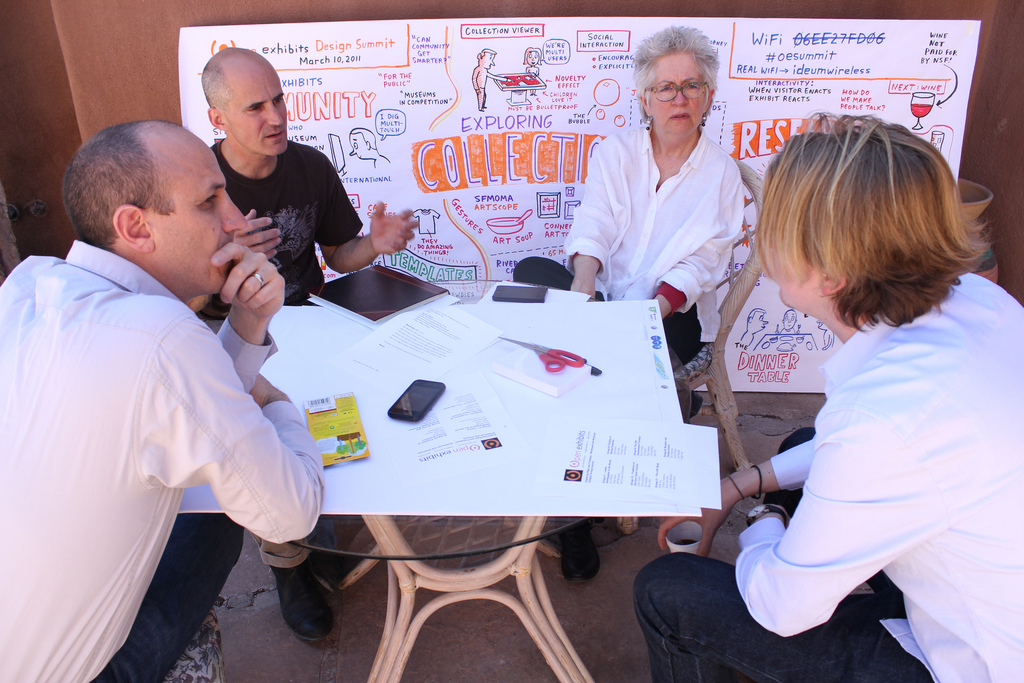
About the HCI+ISE Conference
HCI technologies, such as motion capture, multitouch, augmented reality, RFID, and voice recognition are beginning to change the way computer-based science exhibits are designed and developed. Human Computer Interaction in Informal Science Education (HCI+ISE) is a first-of-its-kind gathering to explore and disseminate effective practices in developing a new generation of digital exhibits that are more intuitive, interactive, and social than their predecessors.
The HCI+ISE Conference, held in Albuquerque, New Mexico June 11-14 2013, brought together 60 museum exhibit designers and developers, learning researchers, and technology industry professionals to share effective practices, and to explore both the enormous potential and possible pitfalls that these new technologies present for exhibit development in informal science education settings.
HCI+ISE focused on the practical considerations of implementing new HCI technologies in educational settings with an eye on the future. Along with a survey of how HCI is shaping the museum world, participants were challenged to envision the museum experience a decade into future. The conference results provided a concrete starting point for exhibit developers and informal science educators who are just beginning to investigate these emerging technologies and design challenges in creating these new types of exhibits.
Why HCI+ISE?
Since the mid-1980s informal educational venues have increasingly incorporated computer-based exhibits into their science communication offerings in an effort to keep pace with public expectations and make use of the expanding opportunities these technologies provide. The advent and popularity of once novel HCI technologies are becoming commonplace: the Wii and Microsoft Kinect now allow for motion capture video games, tablet PCs have multitouch interaction, and smart phones and other devices come standard with voice recognition. Yet many museums are still developing single-touch and trackball-driven, single-user computer kiosks.
Science museums have a long history of championing hands-on, physical, and inquiry-based activities and exhibits. This vast experience has only just begun to be applied to interactive computer interfaces. Along with seasoned science exhibit developers, the Conference drew upon individuals outside of ISE who provided fresh insight into the technologies, design issues, and audience expectations that these visitor experiences present.
Involvement and Findings
HCI+ISE brought together a diverse group of practitioners and other professionals to discuss (and in some cases share and prototype) new design approaches utilizing emerging HCI technology. Conference news and findings will be distributed through a variety of ISE and museum websites, including this one.
We welcome your questions and comments about the HCI+ISE Conference.
Kathleen McLean of Independent Exhibitions
& Jim Spadaccini of Ideum
HCI+ISE Co-chairs

Co-chairs
-
Jim Spadaccini
Founder/CEO and Creative Director
Ideum -
Kathleen McLean
Principal
Independent Exhibitions
Advisors
-
Jennifer Borland, M.A.
Rockman et al -
Robert Ketner
Manager
The Tech Open Source,
The Tech Museum of Innovation -
Erik Lizee
Director of Exhibit Design and Development
McWane Science Center & Aquarium -
Paul Orselli
President and Chief Instigator
POW! -
Christine Reich
Director of Research and Evaluation
Museum of Science Boston -
Chia Shen, Ph.D.
SEAS Senior Research Fellow
Director of SDR Lab,
Harvard School of Engineering and Applied Sciences (SEAS) -
Monica Smith
Exhibition Program Manager
Lemelson Center,
Smithsonian National Museum of American History

